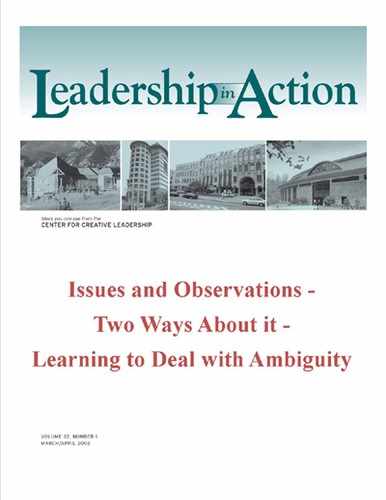AN ACTION PLAN
With all this in mind, it's easy to understand why the ability to deal effectively with ambiguity is on nearly every list of the traits and skills required for leadership effectiveness in a cross-cultural setting. In today's globally oriented, constantly changing, and culturally diverse business environment, ambiguity is pervasive, so leaders need to be able to handle it to be successful. But is the ability to deal with ambiguity a skill that can be developed? I believe it is, and I have some suggestions for how leaders can work on it.
Adjust your mind-set. Cultivate the attitude that new cultural experiences are learning adventures—opportunities to expand your horizons and make yourself a more knowledgeable and complete person. When you face a situation that is dauntingly complex or filled with uncertainty, remind yourself that it is a chance to learn something valuable.
Purposely sustain ambiguity. Don't always be in a hurry to reach closure and certainty. Sometimes it's better to let the clarity of a situation emerge, like the image on a self-developing photograph. Making a conscious effort to sustain ambiguity can be difficult, because the natural, knee-jerk reaction to the stress of ambiguity is to retreat into your cultural comfort zone and interpret the situation through your own cultural lens. But this reaction often leads to misinterpretation owing to stereotypical, ethnocentric thinking and distorted or incomplete data. Try to be patient; wait until all the data are in before attempting to resolve ambiguity.
Be willing to learn from others. Be observant, watching for patterns, clues, and corroborating evidence. Listen, ask questions, and ask more questions.
Learn about other cultures and people. The more you do so, through experiencing other cultures and absorbing information about them, the better you will be at anticipating what might happen and interpreting what does happen in cross-cultural situations. People learn best from experiences that are challenging, so it's helpful to put yourself in a wide variety of cross-cultural situations, both professionally and personally. And there is a wealth of information about other cultures, so take advantage of it and do your homework.
Look at situations as both/and rather than either/or. Work at viewing life as a series of continuums rather than polarities. In a world of increasing diversity, there are seldom simple, clear-cut answers, and dealing with ambiguity involves accepting paradoxes and trade-offs. Don't be tempted to take the path of least resistance, which often leads to simplistic explanations and erroneous conclusions.
